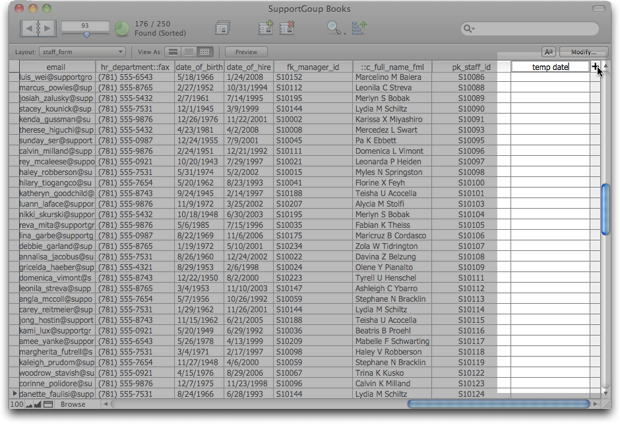I’ll admit it: prior to FileMaker Pro 10, I didn’t give much thought to providing users with the ability to view a layout as a table as opposed to a list. List view seemed to have so much more to offer. Formatting was easier to control, you didn’t have to take extra steps to ensure the header and footer would appear, and if, like me, you tend to give your fields arcane “database-y” names like ct_nameFull_lfm instead of Full Name, you didn’t have to worry about those names appearing in the column headers. About the only thing table view had going for it was resizable columns.
But FileMaker Pro 10 made me start to think differently. All of a sudden, you could choose to show or hide fields depending on your current needs with the Modify button, without needing to switch over to Layout mode and make actual changes to the layout. Table view provided a useful tool for allowing all users to create their own reports. But it wasn’t quite there… not without the ability to also summarize data.
Now, in FileMaker 11, I’ll say it: table view is awesome! If you haven’t explored all you can do in table view, well… you should. While there are still many reports that need to be built in Layout mode with dedicated layouts and scripts, table view is now the first place I go to analyze data. Whereas once I found myself exporting data out to spreadsheets to do ad hoc reporting, that’s far less necessary with FileMaker 11.
Often, I’ll find myself importing records from some other source and then needing to create a few new fields to store information while I do some data cleanup. In table view, I can add new temporary fields, define the field types and add field options, and then delete any unnecessary fields when done, all without ever opening the Manage Database dialog. 
 Note that this is only works if we’re logged in with a [Full Access] account—FileMaker won’t allow us to create fields without the proper privileges, and that’s a good thing. Once I have my records, producing a quick summary report is easy. If I need to group them by department, it’s just one click to sort them together and create a grouping (sort of like a virtual sub-summary part), and another to choose a color for that part.
Note that this is only works if we’re logged in with a [Full Access] account—FileMaker won’t allow us to create fields without the proper privileges, and that’s a good thing. Once I have my records, producing a quick summary report is easy. If I need to group them by department, it’s just one click to sort them together and create a grouping (sort of like a virtual sub-summary part), and another to choose a color for that part. 
 Adding subtotals is just as easy. Right-clicking the salary field allows us to calculate totals, averages, maximums, etc. In fact, what FileMaker does is create a summary field on the fly for the field in question (which explains why text fields can only be summarized with Counts and Running Counts). Adding those fields as trailing subtotals will place them in each trailing group as well as in a grand summary at the end.
Adding subtotals is just as easy. Right-clicking the salary field allows us to calculate totals, averages, maximums, etc. In fact, what FileMaker does is create a summary field on the fly for the field in question (which explains why text fields can only be summarized with Counts and Running Counts). Adding those fields as trailing subtotals will place them in each trailing group as well as in a grand summary at the end.  If we’re not logged in with full access privileges, FileMaker won’t allow us to create these summary fields from scratch like this, but it will allow us to use any previously defined summary field. So if the developer defined a Salary Total summary field, but not one for standard deviations, we can still get those subtotals. This gives administrators some level of control over our ad hoc reports… and this is a good thing too!
If we’re not logged in with full access privileges, FileMaker won’t allow us to create these summary fields from scratch like this, but it will allow us to use any previously defined summary field. So if the developer defined a Salary Total summary field, but not one for standard deviations, we can still get those subtotals. This gives administrators some level of control over our ad hoc reports… and this is a good thing too!  As we create our ad hoc report, the layout itself isn’t modified. The underlying layout remains the same, and won’t affect other users. But if we find that you want to revert everything back to it’s original condition, we can always use Reset Table View.
As we create our ad hoc report, the layout itself isn’t modified. The underlying layout remains the same, and won’t affect other users. But if we find that you want to revert everything back to it’s original condition, we can always use Reset Table View.  If there’s one word to define FileMaker 11’s expanded table views, it’s “empowerment,” making reporting possible, and even intuitive, for everyone. Creating reports doesn’t have to be the sole province of the database developer. And combined with the new charting features, it may be a while before you really need to open a spreadsheet to slice and dice your data. To which I say: “Way cool!”
If there’s one word to define FileMaker 11’s expanded table views, it’s “empowerment,” making reporting possible, and even intuitive, for everyone. Creating reports doesn’t have to be the sole province of the database developer. And combined with the new charting features, it may be a while before you really need to open a spreadsheet to slice and dice your data. To which I say: “Way cool!”

